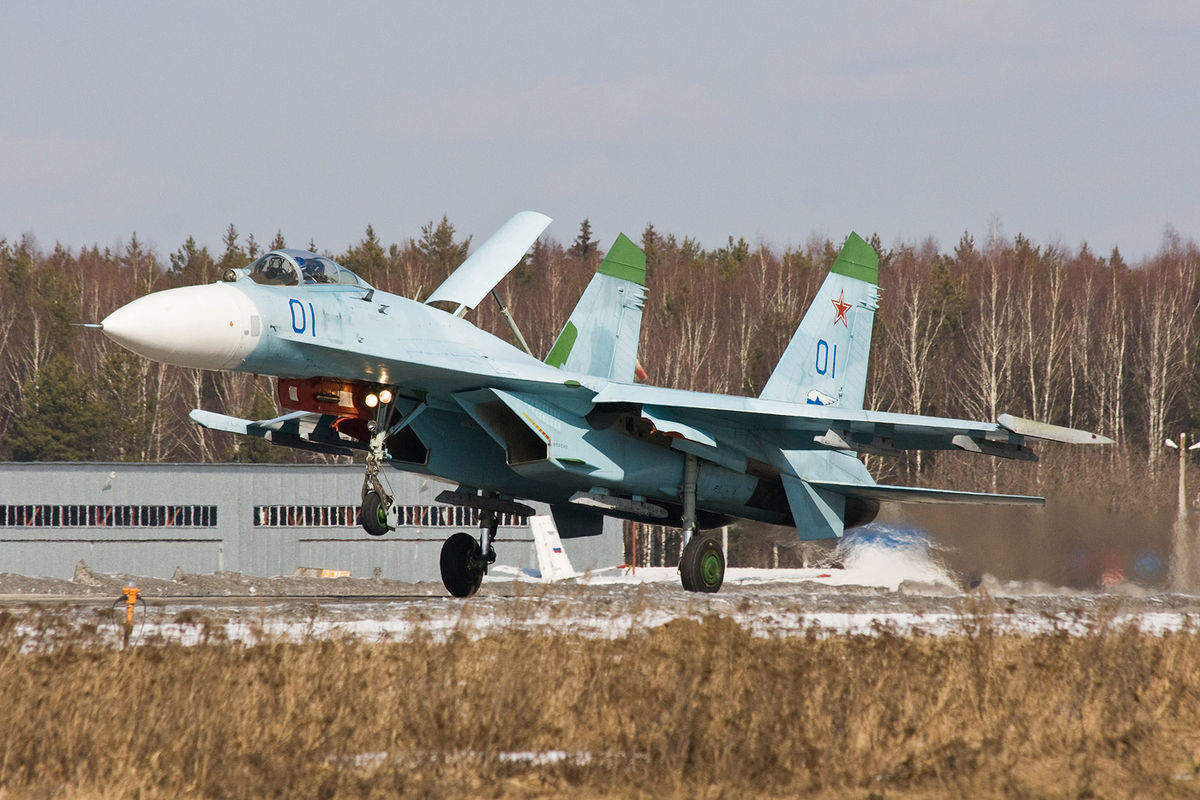As the Russia-Ukraine war rages on, a footage has surfaced on social media depicting an encounter between what appears to be a Russian Su-35 fighter jet and a Ukrainian Mi-14 chopper.
‘Tail Up & Nose Down’ – Why World’s Best Selling Fighter Jets Are Crashing In A Very Predictable Manner?
The video is said to have been filmed near Odessa Bay. Russian fighter jet seen in the video is supposedly a Sukhoi Su-27/30/35 fighter jet firing at the helicopter with its GSh-30-1 30 mm cannon, while the helicopter according to many accounts is a Mi-14PS helicopter of the Ukrainian Navy.
The helicopter tries to evade the Russian fighter jet by flying at an extremely low altitude near the water’s edge and appears to be successful as the fighter’s volley of 30 mm rounds misses their target.
However, its success seems to be short-lived, as the caption accompanying the video and reports in Russian local media claimed that the fighter goes around for another attack and fires an R-73 Archer IR-guided air-to-air missile, which brings down the Mi-14 chopper.
EurAsian Times could not confirm this independently. The video cuts off before the purported downing of the chopper.
This is reportedly video of a Russian fighter attempting to shoot down a Ukrainian Mi-14 helicopter in Odesa Oblast. The Russian source claims the helicopter was shot down with an R-73 air-to-air missile on the next pass.https://t.co/OsSmfMqVJQhttps://t.co/5wkBucElDW pic.twitter.com/UQ8Oyz9x9o
— Rob Lee (@RALee85) June 7, 2022
Low Flying Targets Are Difficult To Engage
Attacking a low flying target is always a difficult task for a fighter jet, especially in case of a low and slow target, such as a helicopter that forces a much faster aircraft, such as the fighter jet in the video, to voluntarily fly towards the ground at sustained speed in order to acquire the target and engage with guns at close range, as the surrounding terrain might confuse the IR sensors of short-range air-to-air missiles.
However, the R-73 missile purportedly used in this case is perhaps an exception. It is one of the world’s first fourth-generation air-to-air missiles and according to Air Commodore KB Menon (Retd.) of the Indian Air Force (IAF), the missile uses an advanced cryogenic seeker to improve the “capture” of the target. The missile is said to have a “look down, shoot down” capability, which cuts through the ground clutter and therefore can be used against low flying targets.

The R-73 is known to have two versions, R-73 RMD-1 and R-73M RMD-2, differing mainly in their target designation angles: 45° for the RMD-1 version and 60° for the RMD-2 version.
In addition to a wider target designation angle, the RMD-2 version is said to have improved capabilities for attacking low-flying targets, therefore being the more likely one to have been fired at the low-flying Ukrainian Mi-14 in question.
Was It The Mi-14PS Carrying The Ukrainian Navy’s Deputy Commander?
The video is said to have been recorded on May 7, 2022. Interestingly, on this day, both Ukrainian and Russian sources confirmed the death of the Deputy Commander of the Ukrainian Navy, Colonel Ihor Bedzay while flying in a Mi-14PS helicopter which was shot down by an air-to-air missile fired by a Russian fighter jet.
The Russian defense ministry claimed to have foiled a Ukrainian military campaign to reclaim the Russian-occupied Snake Island, ahead of Moscow’s May 9 Victory Day Parade.
Around the same time frame, EurAsian Times had also reported about the series of aerial attacks on the island which included daring bombing attacks carried out by two Ukrainian Su-27s that destroyed multiple targets in a single pass.
#Ukraine: The Ukrainian Air force is still alive- seen here are two Ukrainian Su-27 striking Russian facilities on the famous Snake Island in the Black Sea, in remarkable footage filmed by a TB-2 drone.
As we can observe, there is serious damage. pic.twitter.com/ogN3gOU8uJ
— ?? Ukraine Weapons Tracker (@UAWeapons) May 7, 2022
The ministry said that Ukraine had lost 30 drones, three Su-24 bombers, one Su-27, three armored amphibious assault boats, ten helicopters and more than 50 troops in the attempt to take back the islands. It also claimed that among the dead was Colonel Ihor Bedzai.
As stated above, the video is said to have been filmed near Odessa Bay which is in close proximity to Snake Island, therefore, it is possible that the helicopter in the video is Colonel Bedzay’s Mi-14, just a few seconds before it was shot down.

Colonel Bedzey was famous for his exemplary show of leadership during the Russian Invasion of Crimea in 2014, when he was the Commander of the 10th Naval Aviation Brigade based in Novofedorivka, near Saky, Crimea.
He was responsible for the relocation of Ukrainian aircraft to the mainland before the Russians could seize thems.
“In 2014, colonel Bezday was among those few who had the leadership skills and boldness – while all the other officers were waiting for orders from Kyiv,” said Taras Chmut, head of the Come Back Alive NGO who is known to have first shared the news of Bezday’s death.
“He organized personnel, prepared the equipment, and organized the logistical operation to relocate Ukrainian aircraft [from Crimea] to the mainland. The next day, he did the same with aircraft that hadn’t prepared to depart on the first day. The leadership skills of Igor Bezday allowed us to preserve Navy aircraft.”
According to Chmut, Bedzay died while “conducting a military operation with the Mi-14 marine helicopter hit by a Russian fighter jet.”
- Contact the author at tanmaykadam700@gmail.com
- Follow EurAsian Times on Google News




